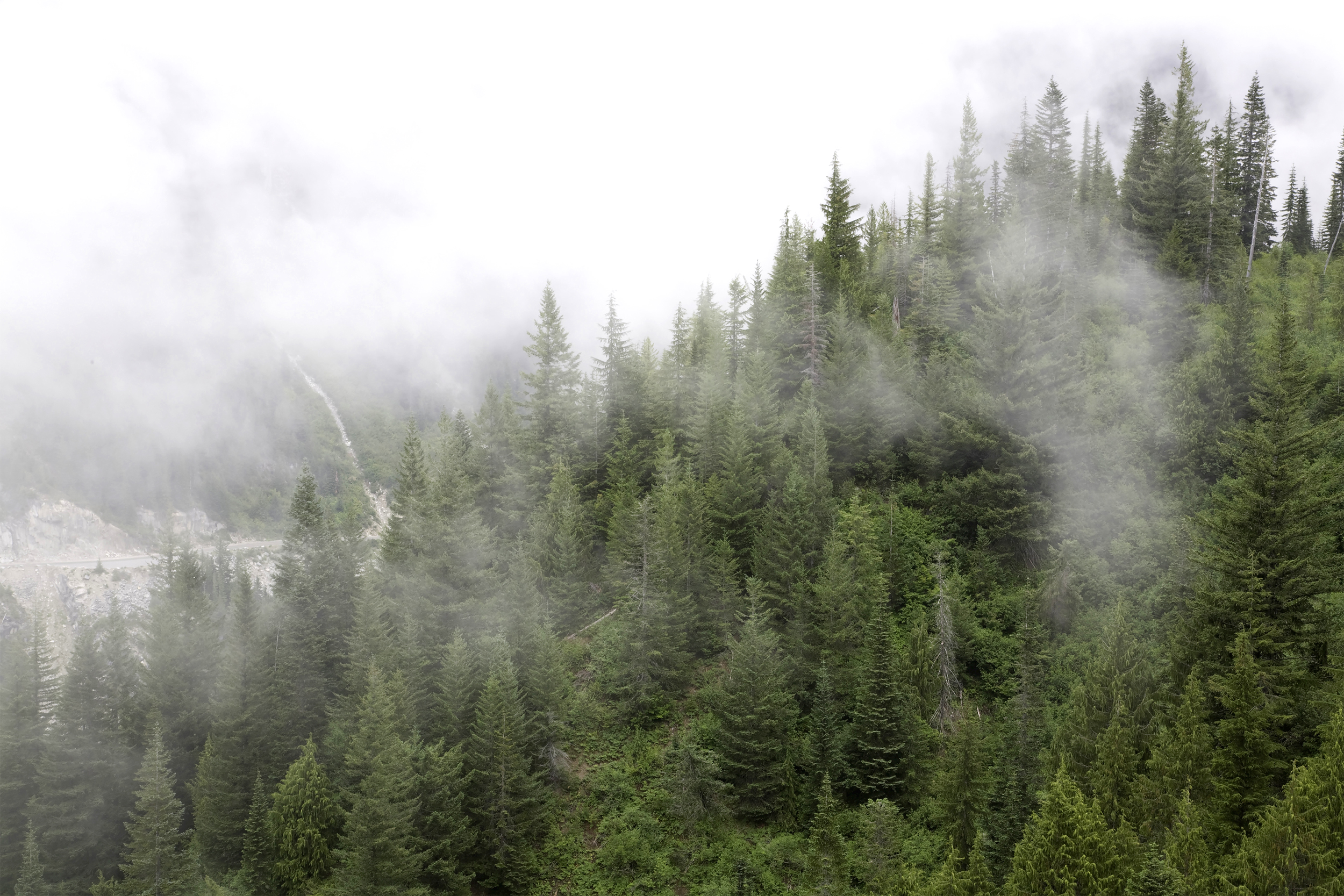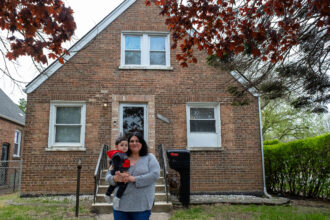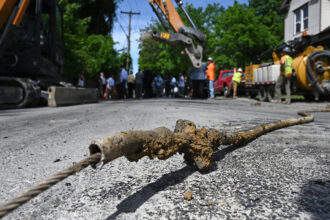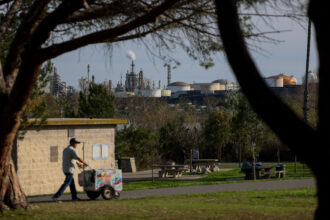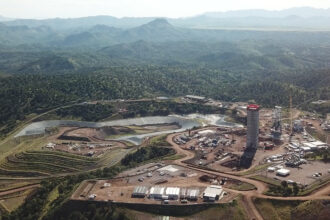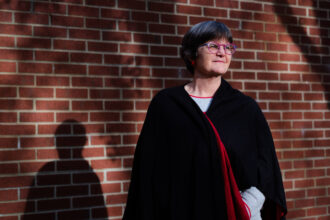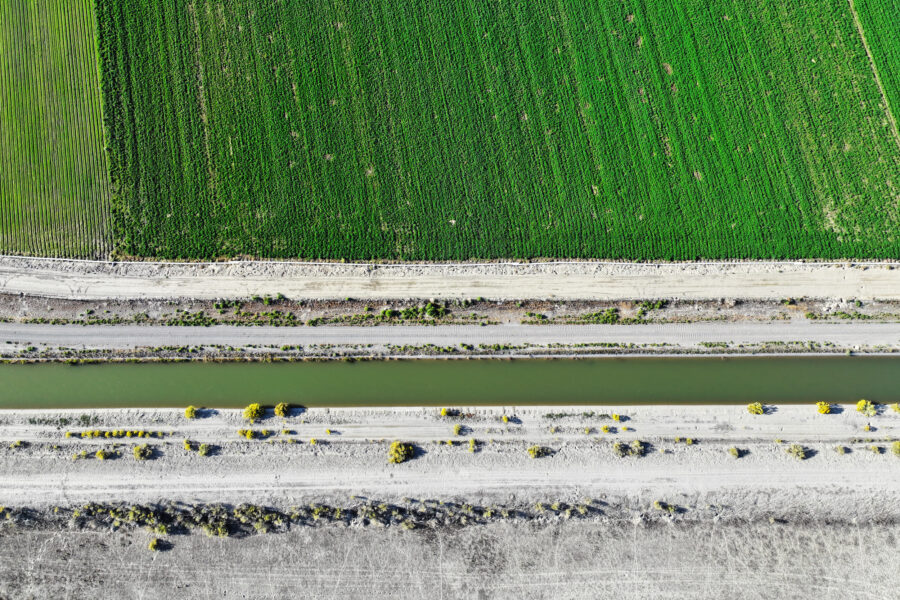From our collaborating partner “Living on Earth,” public radio’s environmental news magazine, an interview by host Steve Curwood with Caroline Fraser, the author of “Murderland: Crime and Bloodlust in the Time of Serial Killers.”
From Ted Bundy and Jeffrey Dahmer to Charles Manson and the Zodiac Killer, serial killers are a distinctly American phenomenon. We have more in our history than the next 10 closest countries combined. And many of these serial killers were active in the 1970s in the Pacific Northwest.
Seattle-born author Caroline Fraser offers one possible explanation in her new book, “Murderland: Crime and Bloodlust in the Time of Serial Killers.” She theorizes that the neurotoxin lead is key to this story. And she links dangerously high lead exposure from smelters and gasoline to the increase of violence and murders in her home state. This interview has been edited for length and clarity.
STEVE CURWOOD: In some respects, this is an autobiography, and you provide some rather intimate details of your life.
CAROLINE FRASER: This book covers a period of time when I was much younger. It was the 1960s, 1970s, and I really wanted to give readers who may not be familiar with that era a kind of flavor of what it was like to be a young person then, to be a young woman in particular, and what it was like growing up in an era when all these serial killings started happening.
CURWOOD: Aside from your own story, this book is about serial killers and the neurotoxin lead, as well as questionable development and even geological damage. How did the idea for Murderland first come about with all those elements?
FRASER: In the Northwest, where I’m from, the question has always been raised year after year of why Seattle and the Northwest in particular seemed to be kind of a hot spot for serial killers. The newspapers were very fond of this topic and constantly were talking about, what is it about this place? People had all kinds of theories—it was the weather or the rain, or maybe it was just too gloomy a place. Maybe it was the highway system.
I’m pointing at another theory to address why this might have happened, and I also am hoping that no matter what you think of this theory, whether you agree or don’t agree, you may learn something about the ecological history and the environmental damage that happened in this place over the past 100 years or so.

CURWOOD: The book opens in your hometown of Seattle in the ’60s. Set the stage for a moment. What was going on at that time?
FRASER: Seattle has always had a very up and down, hot and cold economy. The 1970s were a recession. A lot of contracts were canceled at Boeing. People weren’t building as many houses. People were losing their jobs, and gasoline had become very scarce and expensive. It was a troubled time nationally and regionally for Seattle, and that was the time when I was growing up there and all these bizarre things started happening. The country nationally saw a real rise in violent crime, and so did the greater Seattle area.
CURWOOD: Your book links exposure to pollutants such as lead to the abnormally high level of crime, including serial killers in the Northwest. Let’s focus on Ted Bundy, a famous serial killer. He grew up in the Tacoma area, not so many miles from where you grew up. Talk us through the connection between Ted Bundy’s exposure to lead and his rise as one of America’s most infamous serial killers.
FRASER: I was 13 when he began this spate of abductions and rapes and murders; nobody had really heard of the term “serial killer.” It’s not that they hadn’t existed. There have always been people like Jack the Ripper, for example, but the whole phenomenon of serial killers did not yet exist in the way that we know it now, both from the media, from Hollywood, from books. So it was really kind of an unknown thing.
Now, of course, everybody has heard of Ted Bundy, but one of the things I became really interested in was where he grew up, because he was actually born in Vermont, but then as a young child, moved to Tacoma, Washington.
Tacoma had a very high crime rate—and it also had a lead smelter. It was putting out large amounts of lead and arsenic particulates into the air throughout the whole period when Ted was growing up. And we now know, thanks to research and mapping that’s been done, exactly how much lead was in Ted Bundy’s front yard and his backyard. We know how much arsenic was there. He was exposed to a significant amount of these toxins.
Whether that contributed to what he ended up doing, we certainly can’t know; we can’t prove that. But it’s an interesting fact, because he always seemed like somebody who didn’t seem to have developed in a normal way. Like many serial killers, he had fantasies of rape and murder from a very, very young age. That was something that I was interested in looking at, especially when you see other acts of serial murder that are associated with that same area.

CURWOOD: Ted Bundy was born, as you write in your book, to a mother who had been exposed to lead as well.
FRASER: Ted Bundy’s mother grew up in Philadelphia, which has been called the city of smelters because there was so much smelting activity going on there in the runup to World War II, and throughout World War II. Ted Bundy was born in 1946, just after the end of the war. There are several of these killers who I write about who really were exposed in multiple ways to lead throughout their lives, both as children and as adults, and I think it is a fair question to ask what that might have resulted in.
CURWOOD: Talk to me about how the stories of the other serial killers are linked to Bundy—the geography and the exposure to the neurotoxin lead.
FRASER: One of the other killers who I talk about is Gary Ridgway, who also grew up in the Seattle-Tacoma area, and as a child used to play, according to his brother, in piles of copper tailings, which are the leftover rocks from mining, which themselves contain significant amounts of the kind of toxins that you see coming out of smelters. He grew up near an airport at a time when a lot of general aviation aircraft were using leaded fuel. And as an adult, he worked painting the cabs of trucks, which was at the time using leaded paint. So he’s exposed to lead throughout his entire life, and I think he makes a really interesting example of this kind of exposure.
Another killer is Richard Ramirez, who grew up in El Paso, Texas, where the company that owned the smelter in Tacoma had another smelter. This was Asarco, the American Smelting and Refining Co. El Paso had been the recipient of the fallout from that smelter for many, many years. Richard Ramirez, too, shows a lot of developmental difficulties as a child, somebody who had seizures and developed a very, very violent fantasy life as a kid, which then he acted upon some years later as a young man in Los Angeles. I thought it was fascinating that although we know Richard Ramirez from what he did in L.A., he grew up in a completely different place and was exposed to lead.
CURWOOD: Less than 8 percent of serial killers are women; they’re almost always men. Why do you think that is and how might that be related to their exposure to lead in childhood and adulthood?
FRASER: There have been some studies on this that show that the development of the male brain is affected much more grievously than the development of the female brain in childhood if you’re exposed to lead. The development of parts of the brain like the frontal cortex, [which] control impulsivity and aggression, they’ve shown through brain scans of people who’ve been exposed to lead that the effects are much more notable in men than in women.
This story is funded by readers like you.
Our nonprofit newsroom provides award-winning climate coverage free of charge and advertising. We rely on donations from readers like you to keep going. Please donate now to support our work.
Donate NowCURWOOD: Let’s talk for a moment about the Cincinnati Lead Studies. What were the findings of that research, and why are they still relatively unknown?
FRASER: That’s a great question, as to why they’re not as widely known as they should be. The Cincinnati studies were a very long-term series of studies that looked at kids who were exposed to varying amounts of lead and then followed them until they became young adults.
The findings, fairly strongly, showed a correlation between lead exposure in children and in pregnant women and the behavior of these kids in the teen years and early 20s, when most violent crime is committed. There was a real strong suggestion that lead was responsible, to some extent, for a rise in violent behavior and impulsivity, in heightened aggression, in juvenile delinquency. It’s a very important series of studies.
I’m not sure why it hasn’t received as much attention as it should have, but I suspect a lot of that had to do with the ways in which the lead industry itself was dedicated to convincing people that lead was safe and that this was really merely a correlation, that it wasn’t something that we should be concerned about. They were dedicated for years to covering up the actual information and studies that showed that lead is not safe and that there’s no amount of lead that is safe in the human body.
CURWOOD: What does the removal of lead from gasoline tell us about lead and violent crime?
FRASER: The fascinating thing about the correlation between leaded gas and violent crime is that you see a very sharp rise in violent crime in the 1970s. It was over 10 per 100,000 people, and we’d never in the records of the FBI reached that before. That correlates with the post-World War II boom in people driving, which begins in the 1950s. People are buying more cars and commuting longer distances. There’s more leaded gas entering the atmosphere.
We talked about the Cincinnati studies that showed that children exposed to lead may develop heightened aggression 20 years later. That’s what you’re seeing. You see the rate of crime rising in the ’70s and ’80s, and continuing through the early ’90s. What happens during that period is that we have the Clean Air Act and the EPA being established. We have regulations [for] leaded gasoline, and then you see a very sharp drop off beginning to happen with violent crime.
CURWOOD: A key part of your book considers how we tend to ignore and deny the science of major risks such as lead exposure. Why do you think that is?
“Until we develop some kind of system that puts the onus on the corporations to begin with, we’re really just going to always be behind the eight ball.”
FRASER: I don’t think we’re very good at planning far into the future. … You see this in the government preparations for pandemics and so forth. It’s very hard to get people to invest money and time in things that don’t seem to be an immediate problem. And I think people just don’t like to think about it. They don’t like to think about the ramifications of what might happen, of what could be waiting for us. As human beings, we just come with some inherent limitations that keep us from doing things that are in our best interests.
But obviously there are enormous stakes too, financially. For decades, it was very hard to get the smelter companies, for example, to deal with anything that they were putting into the air. They didn’t even want to release any of the information they had. The system is really broken in terms of just waiting until these corporations have done the worst that they can do, and only then do we go after them to clean it up. Until we develop some kind of system that puts the onus on the corporations to begin with, we’re really just going to always be behind the eight ball.
CURWOOD: Some would say that applies to the climate emergency as well.
FRASER: Absolutely. You know, if you look at what Exxon and Standard Oil and so many of these corporations have done, they knew about this. They knew about it for decades and lied about it, which is exactly what the smelters did. When you’re trapped in that kind of reality, I think you have to ask yourself, do we need to reform the system from the ground up? And we do, but it’s increasingly difficult to see how to make those kinds of changes.
CURWOOD: To what extent does this book scratch the itch that you had going back many years, when you were living in a community where there was a lot of fear about serial killers?
FRASER: It was an enormously fascinating thing for me to be able to confront some of these stories, some of these theories, and try to make some sense out of it. Whether you believe the theory or not, there’s a whole history of environmental damage that was perpetrated on the Northwest, a place that I love dearly, and on many other places around the American West and in the United States during that era.
And the history is important, whether you care about the serial killer angle or not. It’s a really troubling and important history that I think if we understand it, it might help us make better decisions in the future.
About This Story
Perhaps you noticed: This story, like all the news we publish, is free to read. That’s because Inside Climate News is a 501c3 nonprofit organization. We do not charge a subscription fee, lock our news behind a paywall, or clutter our website with ads. We make our news on climate and the environment freely available to you and anyone who wants it.
That’s not all. We also share our news for free with scores of other media organizations around the country. Many of them can’t afford to do environmental journalism of their own. We’ve built bureaus from coast to coast to report local stories, collaborate with local newsrooms and co-publish articles so that this vital work is shared as widely as possible.
Two of us launched ICN in 2007. Six years later we earned a Pulitzer Prize for National Reporting, and now we run the oldest and largest dedicated climate newsroom in the nation. We tell the story in all its complexity. We hold polluters accountable. We expose environmental injustice. We debunk misinformation. We scrutinize solutions and inspire action.
Donations from readers like you fund every aspect of what we do. If you don’t already, will you support our ongoing work, our reporting on the biggest crisis facing our planet, and help us reach even more readers in more places?
Please take a moment to make a tax-deductible donation. Every one of them makes a difference.
Thank you,

